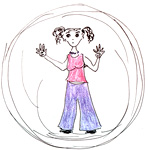
April 22, 2010
usability evaluation: hooman
Posted by dogpossum on April 22, 2010 1:00 PM in the category design and learning | Comments (0)
Design Item 7: hoomans.
This item will be evaluated for usability using heuristics inspired by (but not elucidated in) lecture discussions of Chignell and Valdez. As I have already discussed, these heuristics are developed by my use of van Welie et al.
As per previous usability evaluations, I take myself as the user group evaluating the item. As Nielsen and Molich argue, usability evaluation can only be truly effective with the use of a series of evaluators with different needs and interests. This particular evaluation, then, is limited as a tool for assessing the usability of this item for a broad pool of users. It is, however, very helpful in assessing the usability of the hooman for one particular user and provides a beginning point for ongoing discussion and evaluation of a series of usability heuristics.
The hooman comes in two key types - male and female - yet there are variations and combinations of these types. For this project I will assess the hooman of the conventionally 'female' physical sex, as that is the type I have most experience with and use most often. I will specify further, and evaluate the urban-dwelling, middle class, 35-year old, Anglo-celtic, female hooman. Sexual preference and education are key factors, and though they may be investigated in further research, the scope of this project is such that these cannot be explored here. From this point I will refer to the item as 'hooman', rather than 'female hooman', though this is not to suggest that all hoomans are interchangeable: each particular item has its own individual features and usability issues.
usefulness
The hooman body is a particularly useful item. Even with some minor damage, this item is both practical and aesthetically pleasing. The hooman can be used for a range of domestic and professional tasks, and I have not yet found the limit of its usefulness. It is particularly useful for physical activities, ranging from intensive physical exercise to creative work, but also lends itself to quiet, sustained projects which do not require any physical movement at all.
effectiveness
The hooman is an effective tool for both complex, long-term projects, and short, simple tasks. The small digits on the upper limbs are both flexible and highly sensitive and can serve as useful extensions of the high-powered internal operating system. Though the item is currently less effective for long-distance, high-powered locomotion, skilled users with the ability to refine and develop the item for this particular use would no doubt have more success than I.
learnability
The hooman is a particularly learnable item. Learning to use the hooman is both satisfying and expedient, though more complex tasks require more sustained learning periods. Though there is no help function or documentation accompanying this particular hooman, the aesthetically pleasing appearance of the item teamed with the enjoyable operating environment encourage experiential learning and skill development through use.
likability
As I have noted already, likability is highly subjective, and in part determined by the context within which an item is used. Despite this point, the hooman could have very broad appeal for a range of users. Its high learnability, combined with its aesthetically pleasing appearance (which is likable in large part for its adaptability and mutability) and extensive usefulness make it a flexible, poweful tool for most users.
Chignell, M. & Valdez, J. 1992, 'Methods for Assessing the Usage and Usability of Documentation', Third Conference on Quality in Documentation, at the Centre for Professional Writing, Waterloo, Ontario Canada, pp. 5-27.
Nielsen, J & Molich, R, 1990, 'Heuristic evaluation of user interfaces', in CHI '90 Proceedings, Seattle, WA, pp. 249-256.
van Welie, M., van der Veer, G.C. & Eliëns, A. 1999, 'Breaking down Usability', INTERACT '99, Edinburgh, Scotland, 30th August - 3rd September 1999, http://www.welie.com/papers/Interact99.pdf





Comments
Post a comment